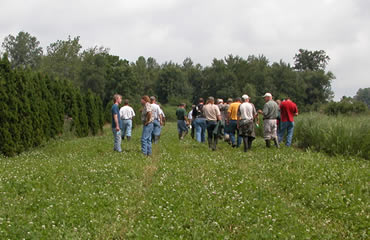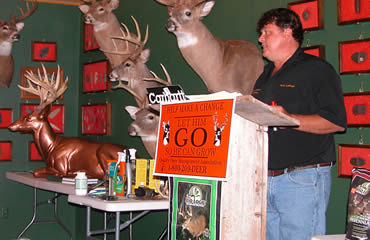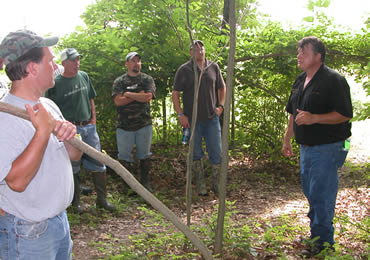The most respected deer expert you’ve never heard of shares a few words of wisdom.
Tony LaPratt is not a deer biologist. He’s not an agronomist. In fact, he never went to college. He doesn’t have a television show, and he’s never written a book or magazine article. You won’t find his instructional DVDs anywhere, either.
“I know I’m fat and I don’t say things right. I don’t have to go on TV or do a video to prove it,” says LaPratt, a burly 47-year-old former farmer and fanatical bowhunter who lives in the same central Michigan county where he was born. “I can’t write, can’t even run a computer. I’m a redneck farm boy.”
In addition, Tony LaPratt may also be the most respected authority on whitetail habitat and deer hunting that you’ve never heard of.
“Tony is the real deal, no doubt about it,” says bowhunting and whitetail habitat pioneer Craig Dougherty, head of the Quality Deer Management Association, an organization based on the free exchange of information and strategies. “Some folks don’t like it because he charges for information and wants everyone that he shares information with to pledge secrecy. But it’s all very good information, and he has a unique angle.”
Obsessive-compulsive, fueled by Diet Mountain Dew, the face of a pudgy schoolboy and delivery of a used car salesman — that’s Tony LaPratt. His words flow with passion in a high voice punctuated by a squeaky cackle.
 “We are basically deer developers,” explains Tony. “We build deer motels. We have all kinds of rooms for bucks and does, even fawning areas. We have all kinds of restaurants, which are food plots with a large variety menu.
“We are basically deer developers,” explains Tony. “We build deer motels. We have all kinds of rooms for bucks and does, even fawning areas. We have all kinds of restaurants, which are food plots with a large variety menu.
“Everybody needs a place to drink, so we build watering holes. They need a place where everyone can meet, so we design and build the ultimate hangout spot. You want your deer hotel to have lots of rooms so when your neighbors make a mistake, their deer check into your motel. Sort of ‘We leave the light on for ya’ for deer.”
Using sportsmen’s shows as marketing; intensive three-day, hands-on boot camps at his Branch County, Mich., complex; and personal evaluation and consulting trips as a pulpit, Tony’s Ultimate Land Management (www.TonysULM.com) is thriving.
Tony’s wife, Lesa, known around the farm as Alpha Doe, provides the structure, organization and business sense of ULM. Longtime friend and partner Chris Pierson is the right-hand man. They allow Tony to be Tony.
“Managing habitat is not about what’s in a food plot, it’s about what’s around it,” Tony said. “Beds, scrapes, paths, cover — that’s what you have to manage. The only thing that is even slightly predictable about big bucks is the way they relate to terrain.”
The manipulation of deer and their habitat has long been Tony’s passion. Since 2003, it has also been his professional life. That’s when he decided to pursue his dream and abruptly shuttered an ultra-successful produce farming business he and Lesa had run for nearly 30 years.
His land management tactics include planting soft areas of high grasses around food plots of clover, corn, turnips and alfalfa. His favorite grasses are Cave-In-Rock and Blackwell switchgrasses.
His food plots are ingeniously segmented using thick landscaping grasses as partitions so a buck looking for does must travel a specific route in order to check the various sections of acreage.
 Clever use of mock scrapes and rub lines can keep a buck interested and busy for a long time, all within proximity of a strategically placed stand.
Clever use of mock scrapes and rub lines can keep a buck interested and busy for a long time, all within proximity of a strategically placed stand.
Tony is able to build gender-specific bedding areas, too. “Does bed for convenience; bucks bed for security,” he says. He also creates large safe areas where deer can find sanctuary throughout the season.
Holding does on the property with food and shelter also holds bucks, for obvious reasons.
LaPratt’s technique is so refined, he can manipulate where the individual animals bed within the cover. And, of course, their trails to and from the bedding areas go right by a treestand.
All of the attraction and manipulation is for one reason: hunting big bucks.
“Covering your move to and from the stand is essential. If they see you, it’s all over,” says Tony, who uses specific brush-cutting techniques to manipulate deer trails. “You want to select your stand location first, then arrange the habitat so the deer come past that particular location.”
The 52 acres around the LaPratt home include 25 acres of woods segmented by a deep slough. It is his laboratory and personal hunting preserve. Every one of his stands is situated so he can see two or three other stands. The non-wooded segments of his acreage are an ever changing research area of planned grasslands, experimental food plots and strategically segmented, mounded and bordered areas that provide feeding and security areas.
LaPratt’s fame has spread steadily through word of mouth and internet exposure. But don’t expect to go into a chat room and find Tony’s Ultimate Land Management and strategies outlined in detail.
Dispensing information through personal visits and his boot camps are Tony’s sole means of income, and he asks his students to keep the information to themselves — which they do faithfully. That plea for secrecy among his clients separates him from the rest of the industry.
“Physics had Einstein. The deer world’s equivalent is Tony LaPratt,” said Minnesota hunter Tom Budnik upon graduation from Tony’s Boot Camp.
Pierson explains that a lot of guys come to the Whitetail Boot Camp thinking they will pick up one or two new things to do. They are basically overwhelmed with all the new tactics, concepts and setups.
“(Habitat building) is not easy,” says Pierson. “It takes hard work and maintenance every year. The good news is if hunters do exactly what we recommend, the benefits outweigh the work.”
In addition to the two days of field work, Boot Camp attendees receive a workbook and classroom lessons on building and designing buck and doe bedding areas, stand placement, sneak trails, food plots, the creation of fawning areas, building staging areas for bucks, shooting lanes, funneling deer and, of course, management for bucks.
LaPratt is die-hard reader, but his education in deer hunting is largely via observation and experimentation.
 “Hunters see things like predators,” Pierson says. “Tony teaches you to look at it all as a prey animal. It’s really common sense once he explains it to you. You can see why it works.”
“Hunters see things like predators,” Pierson says. “Tony teaches you to look at it all as a prey animal. It’s really common sense once he explains it to you. You can see why it works.”
When the LaPratts were running the produce stand, farming and sales consumed less than half of the year, leaving Tony free to work elsewhere “until Oct. 1 each year. I wasn’t available after that,” Tony said.
In those years, his obsessive-compulsive behavior led him to treestands two hours before daylight. And he would stay until “black dark.” The treestand was an observation post, his classroom and, later, his research center.
“It wasn’t efficient, not at all,” Tony admits of his extended time aloft. “But it was effective. It gave me lots of time to observe, to question and to think about what was going on and why.
“When I first started, I used to clear brush for 40 yards around my stand. Then I’d watch all the bucks skirt the edge in cover. I realized I didn’t want to remove the cover but rather to build cover to my advantage.”
Applying his trapping skills in deer hunting, Tony began to think about ways to bring animals to his land, then to specific stand locations.
“I made all the mistakes everyone makes and some nobody else ever thought of. But I learned.”
Through his reading habit, Tony studied theories on deer behavior and found that some were right, some were wrong and some were caused by issues the author might not have considered.
“You learn from trapping that little details make a big difference,” he says.
Tony shot his first truly big buck on his property, a massive 10-pointer, with a shotgun in 1983, but lost it on the neighbor’s land. He took another big one in 1987 and has scored regularly on 140- to 160-inch bucks ever since — 32 in the last 23 years.
He’s a devout believer in scent control, but his success with big bucks has been achieved without items and techniques most deer magazines would have you believe are essential. He does not believe in attractant scents, grunt tubes, trail cameras, ATVs or rattling antlers.
His strategically placed ladder stands are all hand-built of wood. They’re all camouflaged, 20 feet high with no squared edges that might draw the attention of a prey animal’s discerning eyes.
In the early years, he averaged more than 50 days in a treestand for each buck. Now, it’s as little as two or three days, and always with a bow. He stays out of the hunting area until mid-October when pressured bucks start showing up from other properties, and his own bucks start to mark their territory.
The deer are totally free-ranging, but the 160-inch 13-pointer that Tony harvested in 2008 was the seventh 150-plus inch buck from the 52-acre tract. Several large bucks have been poached off the property, but each has seemingly been replaced by a big buck drawn from elsewhere.
“It’s 25 acres that lays like 250,” says Pierson, who recently turned his busy contracting business over to a manager and now works full time with ULM.
One friend/customer and LaPratt-believer bought a neighboring 38-acre woodlot and another 100 acres two miles away that Tony developed using his methods, essentially expanding the ULM research grounds by more than 200 percent. Chris’ home, also two miles away, is similarly developed and also is a research site for various other plantings.
In recent years, Tony’s ULM has partnered in the purchase of properties in Ohio, and they’re looking for ground in Indiana.
“We look for several factors,” Tony said about the consulting work. “Some (properties) can be improved more than others, but most can be improved by at least a minimum of two classifications. A lot of what we see is wasted real estate that you’re paying taxes on. It can be improved dramatically.”
Read Recent Articles:
• Test Before You Plot: Why do so many hunters skip a $12 test when it’s a critical part of a successful food plot?
• Scouting Basics: There’s no need to feel lost when stepping onto a property for the first time.
• Fine-Tune Your Frontloader: Modern muzzleloaders are capable of excellent accuracy, but getting them there takes work.
This article was published in the October 2010 edition of Buckmasters Whitetail Magazine. Subscribe today to have Buckmasters delivered to your home.